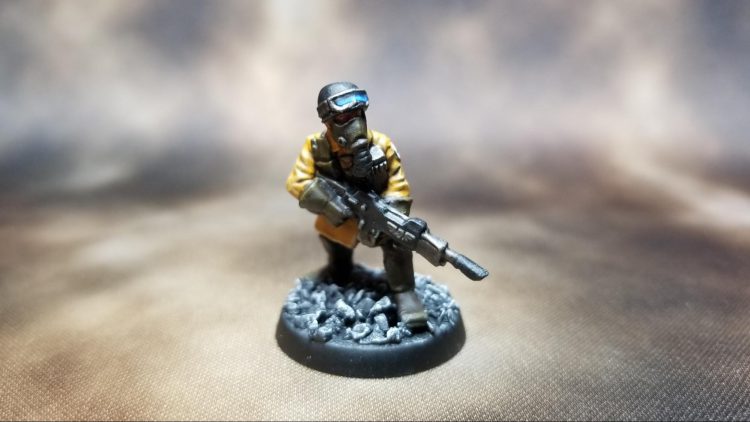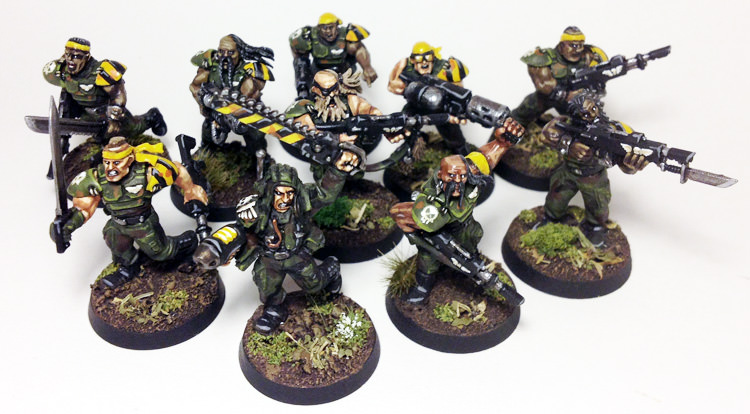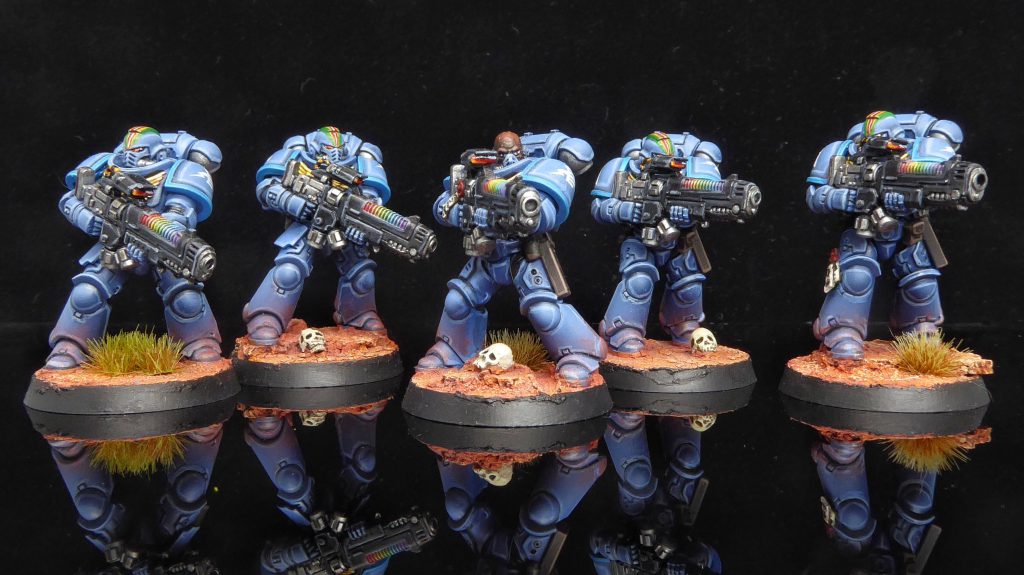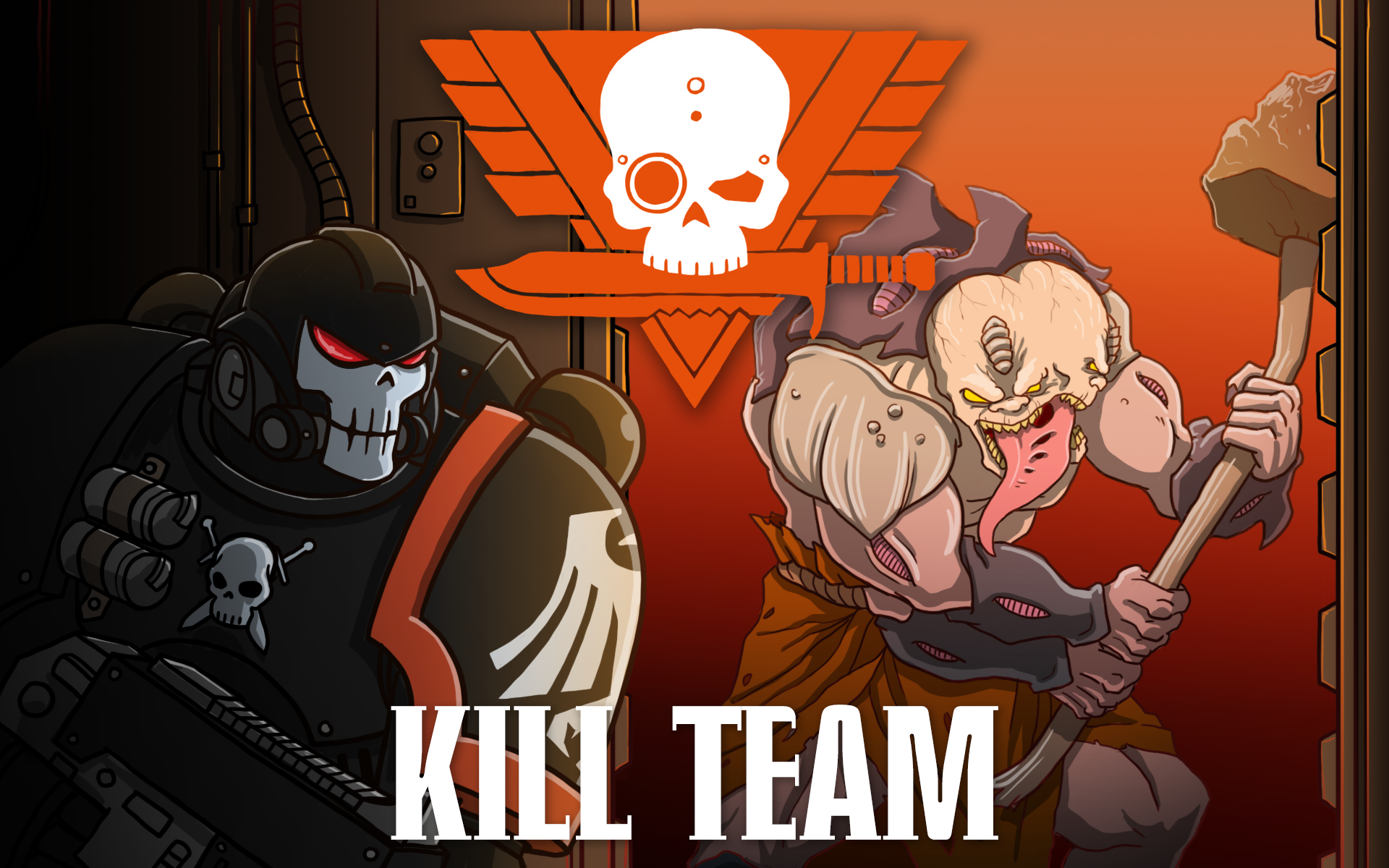Welcome back, Kill Team fans! Yesterday we gave a general review of the new Kill Team release – in case you missed that, you can find it here. In that review, we spoke a little bit about Narrative Play in the new Kill Team but today we’re diving deep into the Narrative Play part of the game to talk about how it works and why it’s great.
Fans of the 2018 Kill Team will likely not have fond memories of Narrative Play in that game, and for good reason: Campaigns in the original Kill Team were little more than an afterthought, a hastily-scribbled set of notes on the last two pages of the Core Rules that outlined a truly terrible system for campaigns, where players would seldom accumulate resources but could often lose them, and could in fact be eliminated from the campaign altogether. The result was a campaign system where the most effective move was often to not play games at all. Not GW’s best work. Kill Team: Rogue Trader introduced us to another angle on Narrative Play, this time with a set mini-campaign featuring the Elucidian Starstriders and the Gellarpox Infected. The models were gorgeous, but the rules themselves were pretty limited and mostly it was a vehicle for setting up Commander and Arena. If you came into Kill Team from Shadow War: Armageddon expecting cool, Necromunda-like team customization and growth, you were sorely disappointed.
So how does Kill Team 2.0 fare?
Before we dive in we’d like to extend another “thank you” to Games Workshop for providing us with a review copy of the new Kill Team boxed set.
Introducing Spec Ops
Spec Ops is the Narrative Play mode in the new Kill Team game. In Spec Ops, players create a Kill Team from a faction of their choice. If the models have a selectable keyword like a Chapter, then all the models have to share that keyword too. From there, they name their team, add operatives, pick a base of operations, and start on their journeys. At the highest level, Spec Ops feels a lot like Warhammer 40k’s Crusade game mode, but with more emphasis on individual model leveling, bases (and base building), and custom equipment. Let’s run through the Core Rules for these one at a time.
Experience in New Kill Team
All of your operatives start with 0 XP, but can gain more as they participate in battles. Operatives earn XP for incapacitating one or more enemy models during a mission (1), completing any actions in a battle or scoring you VP for holding an objective (1), and completing Tac Ops (1). Your current level depends on your XP, with 6 XP taking you to level 2 (Veteran), 16 taking you to level 3 (Ace), and so on. Each time you level up, your operative earns a Battle Honour. If you were wondering where Specialisms form Kill Team 2018 went, here’s where they show back up – the first time you gain a Battle Honour for an operative, you have to choose a specialism for them to specialize in. There are four to choose form, though which ones your operative has access to will depend on the operative – each operative’s datacard has a series of icons that show which ones they can take. The four options are:
- Combat
- Staunch
- Marksman
- Scout
After you pick a specialism, you can pick a Battle Honour from that Specialism. There are 6 per specialism and like with Crusade, you can either pick one (the coward’s path), or roll for it. If there’s one thing I kind of miss from KT 2018 here, it’s the skill trees – which were kind of neat – but these are also much more universal and balanced than those, so it’s not a huge loss.

Combat Battle Honours
Combat honours are pretty much what you’d expect. These help you fight in melee – Vicious for example adds 1 to an operative’s Critical damage when fighting with melee weapons, while Duellist gives enemy operatives -1 WS during a fight, and Bladework lets you re-roll one of your attack dice each time you fight in combat. These are all pretty handy ways to set your operative up for more decisive combats that allow you to escape with less damage, making them a must-have for your power fist operatives who want to charge in and try and kill an enemy in one or two hits.
Staunch Battle Honours
Staunch is the category for your tough dudes, making them harder to kill. There’s some straight fire here, like Stalwart, which prevent your operative from being injured and taking a penalty to their movement in games, while Resilient gives them +2 wounds. Invulnerable is my favorite, just because it has a great name and also it lets you ignore AP1 on shooting attacks that target you. These are great for pretty much everyone and they’re good on your basic “I’m just here to fill a spot and action objectives” guys.
Marksman Battle Honours
These are also pretty straightforward – they make operatives better at shooting. Crack Shot lets you do an extra mortal wound every time you crit, while Gun Ace gives you one re-roll on an attack dice. And Sharpshooter lets you turn one of your 5+ results into a critical hit if you haven’t made a Normal Move, Charge, or Fallen Back that turn.
Scout Battle Honours
Scout Battle Honours are more about moving and changing your orders. Covert lets you do exactly that, changing your order during the first Turning Point – this basically lets you start on Conceal to stay hidden and then swap out to Engage when you activate the first time so you can shoot something across the table. Picket lets you deploy further out of your drop zone during Deployment, and Runner gives you a free Dash action on any turn you don’t shoot or fight. These are the other “anyone can take these” set, since pretty much everyone can use movement boosts, even if they’re more on the melee side.
Casualties, Recovery, and Battle Scars
It’s not all upside – similar to Crusade, in Kill Team when your operatives die in a Spec Ops campaign, they run the risk of sustaining long-term injuries. Unlike Crusade, one of these long term injuries is just straight-up dying. After each battle you roll a D6 for each downed model. On a 2+ you pass, but the operative is capped at 3 XP for the battle. On a 1, you fail the test and get a Battle Scar. Medics can give you re-rolls on these.
When you get a Battle Scar, you have to roll for it, and subtract 1 for each battle scar your operative already has. On a 1, congrats! Your operative is completely dead. Remove them from your dataslate. The others basically give you penalties to different stats and make you act as if you’re injured all the time. If you manage to roll a 6 here you don’t get a Battle Scar but you also don’t get any XP from the battle. These are all positioned as temporary injuries rather than long-term crippling, and the general idea is that you can recover from them, given time. On that note, there’s a mechanic for recovering – after each game you roll a D6 for each operative who has a Battle Scar and add 1 for each consecutive battle they didn’t fight. On a 5+ they pass the test and you can remove one battle scar from them gained in a previous battle (but not the one that just happened).
The Base of Operations
In addition to managing a Kill Team in Spec Ops, you also manage a base of operations, the place where they return to between missions. You name your base at the start of the campaign and while your base doesn’t do anything at the beginning, during the campaign you can outfit your base with a number of upgrades that give it extra rules. These are called Strategic Assets. These upgrades are added using a Requisition called Asset Acquired (more on how RP are acquired later). Your base has a maximum upgrade limit – you start with a max of two, but you can increase your limit by completing Spec Ops (more on those in a bit), up to a maximum of five. You can swap out the ones you have later if you don’t like one of the upgrades you’ve acquired.
The upgrades themselves give you small bonuses that are pretty cool. The Expanded Armoury gives you 4 additional points worth of equipment for your team each game, while the Med Bay lets you re-roll one Casualty test per game. The Comms Network is a stand-out choice here, letting you re-roll when you roll off to determine who has the initiative. These bonuses are cool and if there’s one gripe I have with these rules it’s that there’s no mission for fighting over someone’s base of operations… yet. This seems like a no-brainer and I’m already thinking about how to set this up in a map campaign and create modeling opportunities for players to make bases.

Spec Ops
Ok bear with me: In a Spec Ops campaign the majority of your time is spent completing Spec Ops, which are like longer missions/quests for your Kill Team. After you set up your Kill Team and name your base of operations, you pick a Spec Op for your team. There are ten of these in total, and each one gives you an outline of what the mission is and how you can accomplish it. Each one of these has two parts, labeled “Operations,” and these outline what you have to do to actually complete the Operation. Each one also comes with a “Commendation,” which tells you what you get for completing the thing.
As an example, let’s take the Demolition Spec Op. There are two operations here:
- Plant Charges requires you complete five missions in which you score VP from either the “Plant Signal Beacon” or “Sabotage” Tac Ops
- Detonate requires you complete a game in which you score VP from the “Upload Viral Code” Tac Op
Then when you complete this Spec Op you gain 3 Requisition Points, plus you can either increase your asset cap by one (+1 base upgrade) or add a rare equipment to your stash.
This is pretty indicative of the way these look, and the others have similar set-ups and pay-offs, with fluffy names and descriptions – Infiltrate the Enemy, Extraction, Secure District, Perform Ritual, etc. They’re all pretty cool and they add something that 40k’s Crusade kind of sorely needed, which is a way to add small narrative arcs to a campaign so your games have more of a narrative connection before the fact rather than something you create post-hoc. On the whole, I think these are really cool, and as we’ll see in a bit, Octarius adds faction-specific Spec Ops to work through.

Equipment and Rare Equipment
Equipment plays a major role in a Spec Ops campaign, though in this mode your kill team starts with zero equipment options. Instead as you play games you’ll add equipment to your Stash. This is done by either using the Equipment Drop Requisition or by completing Spec Ops. Every time you do this you can pick a piece of equipment from your team’s options and add it to your stash, and from then on it can be equipped on one of your operatives before each game. Note that if you want to equip the same piece of equipment twice, you need two in your stash.
On top of standard equipment Spec Ops introduces Rare Equipment, which are like Relics for Kill Team. If you complete certain Spec Ops they’ll reward you with a piece of Rare Equipment, which you’ll generate from one of two lists – Ranged and Melee. You can only add one of each to your stash, and the ones in the core rules all cost 2 EP, though the ones for Kommandos and Veteran Guardsmen have different costs. The Ranged Weapons upgrades all improve a single ranged weapon in some way – Thermal Site gives you the No Cover special rule and Auto-loader gives you the Ceaseless special rule, though the best of these is likely Propulsion Amplifier, which improves your Damage characteristics by 1. Likewise Melee Weapons upgrades a single melee weapon. Power Enhancer gives you +1 damage on melee attacks here, Interia Displacer gives your attacks Stun, and Rending Blade gives your weapon the Rending special rule.
Requisitions
Similar to Crusade, Spec Ops introduces Requisitions and with them, Requisition Points. There are seven in the Core Rules, and these are very similar to the 40k set.
- Operative Assigned lets you add another operative to your team
- Equipment Drop lets you add up to 5 points worth of equipment to your stash
- Asset Acquired buys you a base upgrade
- Medivac is used when you roll a Battle Scar for an operative, and lets you treat it like they rolled a 6 instead, getting no XP and being forced to sit out a game. This is how you prevent a model from dying
- Recuperate gives you +1 to your Recovery roll after a game
- Proficient Operative lets you give a higher-level model a second specialism, meaning you can double dip into another list of upgrades. Great for building your top-shelf operatives
- Weaponsmith let you give an operative the ability to be upgraded twice with rare equipment upgrades
These cover a wide range of bases and if you’ve completed some Spec Ops they give you a lot of additional leeway to deal with injuries and help improve your teams.
Balancing Teams
Of course, as players participate in campaigns they’re liable to have teams with uneven amounts of Experience and upgrades. In a similar fashion to Crusade, Spec Ops rewards teams with extra CP if they have fewer battle honours and strategic assets than their opponent, but Kill Team adds the wrinkle that they can choose to take 2 points to spend on equipment instead.
Missions
Somewhat surprisingly, there are no narrative-specific missions for Spec Ops – the book provides 9 symmetrical missions that work just as well for Matched Play as they do for Narrative.
Spec Ops in Octarius
In addition to the Spec Ops rules in the Core Rulebook, the Octarius campaign rules packed in the boxed set also include Spec Ops rules for the book’s two factions – Veteran Guardsmen and Kommandos. These include a pair of custom Spec Ops for each faction, Rare Equipment, Assets, Battle Honours, and Requisitions. For more on those, you can check out our review of the Octarius book here.
Final Verdict
On the whole, these rules seem like a lot of fun. There’s a lot of meat to this, and the custom Spec Ops content for the Octarius teams is really cool as well, adding a lot of flavor in the same way that Codexes improve Crusade options for the 40k factions. There’s a ton of flavor to base building and the rules encourage customizing models and adding to your team in a way that the 2018 game never did. These rules give Kill Team a very Necromunda-esque feel, and that’s absolutely a good thing. If you were looking at yesterday’s review talking about Matched Play rules and missions and wondering if Kill Team might not be for you, let me set your mind at ease by saying that these rules are the best campaign rules I’ve seen from Games Workshop yet.
Have any questions or feedback? Drop us a note in the comments below or email us at contact@goonhammer.com.



